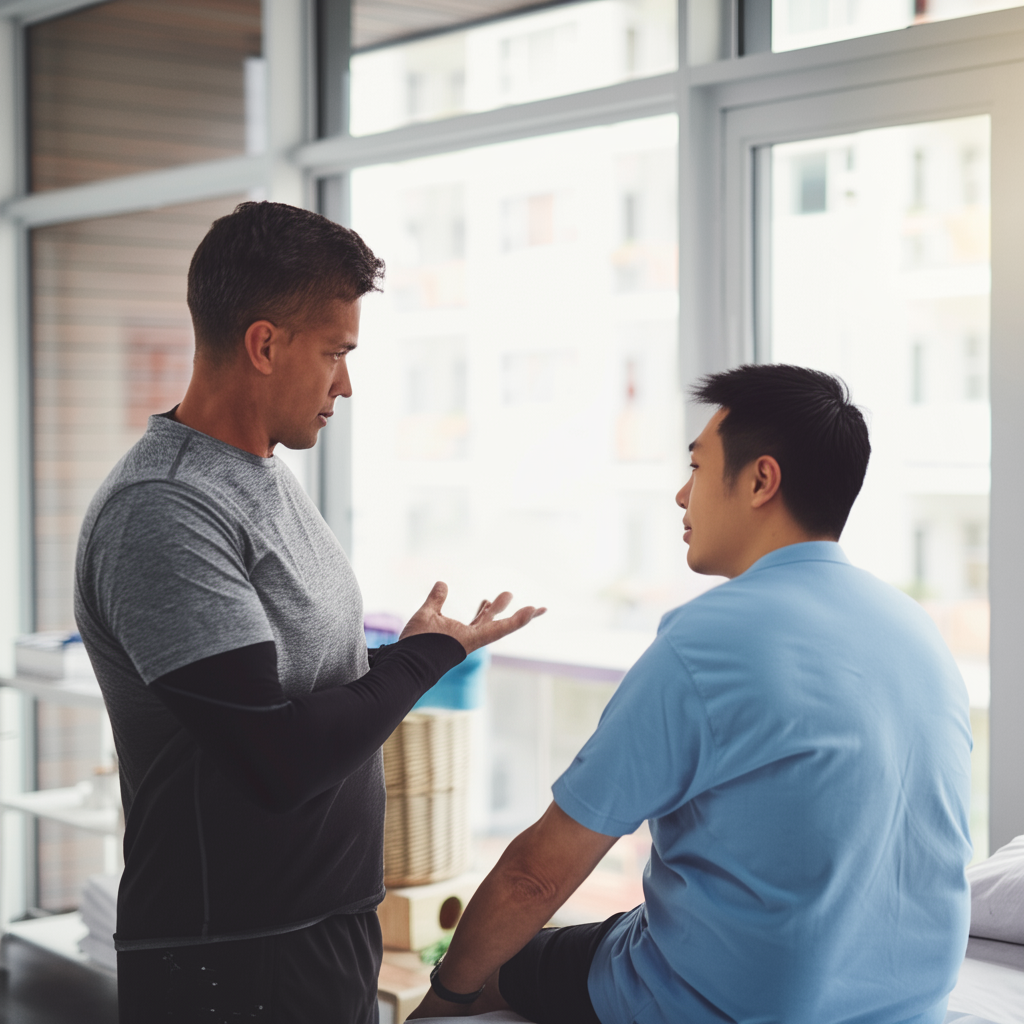骨質疏鬆症如何影響自信心?
骨質疏鬆症不只是身體上的挑戰,也可能影響心理層面,例如:擔心跌倒受傷,導致行動變得保守,甚至影響社交活動;身高變矮、駝背,讓人產生外貌焦慮;害怕疾病惡化,影響心情,甚至引發憂鬱或焦慮。然而,建立良好的生活習慣與積極心態,能夠幫助病人戰勝心理壓力,重新找回自信!
如何幫助病人提升自信心?
了解骨鬆,消除恐懼
知識能帶來安全感。許多病人對骨鬆的了解有限,因此容易過度擔心。透過學習骨質疏鬆的病因、治療方式與日常管理,能夠幫助患者理解——骨鬆並不可怕,只要適當控制,就能避免惡化!
關鍵資訊:骨質流失的速度可透過運動、營養與藥物治療來控制;對於維持骨骼健康,鈣與維生素D的補充是不可或缺的;定期檢查骨密度,有助於及早發現問題,降低骨折風險。
積極運動,強健骨骼
運動不僅能改善體能,也能幫助病人提升自信,因為「做得到」的感覺,能讓人更有掌控感!
適合的運動:
- 阻力運動(肌力訓練):如負重訓練、彈力帶運動,可增強骨密度。
- 平衡訓練:如太極、瑜伽,有助於降低跌倒風險。
- 有氧運動:如快走、爬樓梯,可維持骨骼與肌肉強度。
運動時的注意事項:避免過度彎曲脊椎,減少跌倒風險。根據身體狀況調整運動強度,若有骨折風險,應先諮詢醫師。
設定小目標,逐步提升自信,因為成功達成目標的感覺,能帶來成就感與動力!建議病人從小目標開始,例如每天快走10分鐘,逐步增加運動時間,當自己能夠做到時,就會更有信心。
舉例:第一週:每天散步10分鐘;第二週:增加至15分鐘,並嘗試簡單的肌力訓練;第三週:嘗試加入瑜伽或太極等平衡訓練。
這樣的進步模式,不僅能強化骨骼,也能幫助患者在過程中體驗成就感,減少無力感。
尋求支持,減少孤單感
病人的心理狀態與社交支持密切相關。加入病友團體,或與朋友、家人分享自己的感受,能幫助病人減少孤單,增加正向的互動。
可以這樣做:
- 與家人、朋友分享自己的進步與努力。
- 參加社區的健康活動,如健走團、骨質疏鬆講座等。
- 加入線上或實體病友團體,獲取正向鼓勵。
「你並不孤單!」
當病人感受到周圍人的關心與支持,心理狀態也會大幅改善。
改善生活習慣,養成健康心態
養成健康的日常習慣,能夠提升病人的身心狀態,例如:
均衡飲食
確保攝取足夠的鈣與維生素D,減少攝取加工食品。
戒菸限酒
菸酒會加速骨質流失,增加骨折風險!
維持良好睡眠
充足的休息有助於身體修復與調節情緒。
好的習慣,能讓身體更健康,也能提升心理自信!
案例分享:骨鬆病人如何成功重拾信心?
張女士,71歲,因為年輕時缺乏運動、營養攝取不足,停經後被診斷出骨質疏鬆症。確診後,她一度害怕跌倒,甚至變得不願外出。
然而,在醫師與家人的鼓勵下,她開始調整生活方式——補充鈣質、每天快走、參加太極課程。三個月後,她不僅改善了身體狀況,還開始享受社交活動,重拾了自信!
她的心得:「我以為自己只能待在家裡,沒想到透過運動和健康飲食,我還能活得這麼有活力!」
結語:別讓骨鬆限制你的人生!
骨質疏鬆症雖然是一種慢性疾病,但只要透過正確的管理、運動、營養攝取與心理調適,仍然可以擁有高品質的生活。
別讓骨鬆奪走你的自信! 透過學習、運動、尋求支持,你可以掌控自己的健康,勇敢迎接未來。
Reference
[1] Stem cells in Osteoporosis: From Biology to New Therapeutic Approaches. /Stem cells international /2019 LINK
[2] Osteoporosis in Skin Diseases. /International journal of molecular sciences /2020 LINK
[3] Osteoporosis risk factors, pharmaceutical and nonpharmaceutical treatment. /European review for medical and pharmacological sciences /2021 LINK
[4] Osteoporosis and Fragility Fractures: currently available pharmacological options and future directions. /Best practice & research. Clinical rheumatology /2022 LINK
[5] Controversies in medicine: the role of calcium and vitamin D supplements in adults. /The Medical journal of Australia /2019 LINK
[6] Osteoporosis risk factors, pharmaceutical and nonpharmaceutical treatment. /European review for medical and pharmacological sciences /2021 LINK
[7] Vitamin D: sources, physiological role, biokinetics, deficiency, therapeutic use, toxicity, and overview of analytical methods for detection of vitamin D and its metabolites. /Critical reviews in clinical laboratory sciences /2022 LINK
[8] Role of vitamin D supplementation in the management of musculoskeletal diseases: update from an European Society of Clinical and Economical Aspects of Osteoporosis, Osteoarthritis and Musculoskeletal Diseases (ESCEO) working group. /Aging clinical and experimental research /2022 LINK
[9] Impact of exercise on bone mineral density, fall prevention, and vertebral fragility fractures in postmenopausal osteoporotic women. /Journal of clinical neuroscience : official journal of the Neurosurgical Society of Australasia /2020 LINK
[10] Exercise and physical activity in individuals at risk of fracture. /Best practice & research. Clinical endocrinology & metabolism /2022 LINK
[11] Strong, steady and straight: UK consensus statement on physical activity and exercise for osteoporosis. /British journal of sports medicine /2022 LINK
[12] Effects of Three Interventions Combining Impact or Walking at Intense Pace Training, with or without Calcium and Vitamin Supplements, to Manage Postmenopausal Women with Osteopenia and Osteoporosis. /International journal of environmental research and public health /2022 LINK
[13] Osteoporosis Management in the Era of COVID19. /Journal of bone and mineral research : the official journal of the American Society for Bone and Mineral Research /2020 LINK
[14] Osteoporosis risk factors, pharmaceutical and nonpharmaceutical treatment. /European review for medical and pharmacological sciences /2021 LINK
[15] Coping Strategies Preferred by Patients Treated for Osteoporosis and Analysis of the Difficulties Resulting from the Disease. /International journal of environmental research and public health /2022 LINK
[16] How to implement guidelines and models of care. /Best practice & research. Clinical rheumatology /2022 LINK
[17] Knowledge, Beliefs, Dietary, and Lifestyle Practices Related to Bone Health among MiddleAged and Elderly Chinese in Klang Valley, Malaysia. /International journal of environmental research and public health /2019 LINK
[18] Osteoporosis risk factors, pharmaceutical and nonpharmaceutical treatment. /European review for medical and pharmacological sciences /2021 LINK
[19] How to implement guidelines and models of care. /Best practice & research. Clinical rheumatology /2022 LINK
[20] Risk assessment tools for osteoporosis and fractures in 2022. /Best practice & research. Clinical rheumatology /2022 LINK
